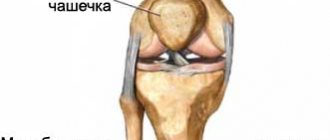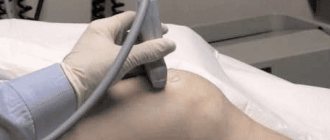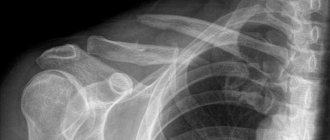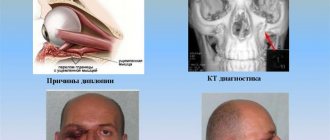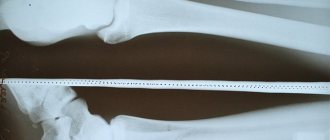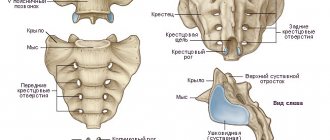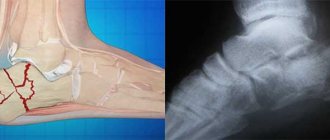From this article you will learn: what a fracture of the patella (patella) is, how and for what reasons it occurs. Its symptoms, methods and terms of treatment, consequences.
Author of the article: Victoria Stoyanova, category 2 doctor, head of the laboratory at the diagnostic and treatment center (2015–2016).
Article publication date: 07/15/2019
Article updated date: 01/16/2020
A fracture of the patella is a violation of the integrity of the round bone located on the front surface of the knee joint.
Healthy patella
Illustration of a patella fracture. Click on photo to enlarge
The cause of a fracture is usually a blow or a fall. Under the influence of a force that exceeds the strength of bone tissue, it collapses and breaks up into separate fragments.
A special type of fracture is a patellar fracture:
- the disruption of bone integrity in this injury is incomplete;
- there is no displacement of fragments (individual parts of the bone into which it breaks up after a fracture) and a clearly defined gap between them (a diagnostic sign of a fracture).
Immediately after a fall or injury, the victim experiences acute, sharp pain, the knee quickly swells and swells. You can step on your foot, but it hurts. Walking and any active movements in the knee are severely limited (otherwise the pain intensifies to the point of unbearable).
Such damage to the patella is not uncommon (according to some sources - from 1.5 to 5% of the total number of fractures), it is more often diagnosed:
- in people over 60 years of age;
- in athletes and people leading an active lifestyle.
In women - 2 times less often than in men.
The prognosis for recovery from a fracture of the patella depends on its severity - non-displaced injuries can be completely cured in 80% of cases. Severe injuries over time can cause arthrosis (when the patella is crushed and removed) or necrosis of bone tissue.
This type of injury is treated by a traumatologist or orthopedist.
The mechanism and causes of this injury
A fracture occurs due to trauma, which can be:
- Direct (cause: falling to knees, hitting the patella).
- Indirect (caused by a sharp and strong contraction of the thigh muscles).
- Mixed (different combinations of 2 previous injuries).
An unfortunate fall can cause a fracture of the patella
As a result:
- the integrity of bone tissue is compromised;
- cracks appear in the kneecap (after a slight impact);
- or it breaks into several fragments.
After an impact, the fragments may remain in place or move (more than 0.5 cm from each other).
Serious injuries with displacement of fragments are usually accompanied by damage (rupture) to the tendons of the quadriceps femoris muscle.
With a minor impact, the kneecap does not fall apart and the muscles do not rupture, but a crack in the patella may occur. The reasons for the appearance of a crack are the same as for a fracture.
Third period
This period begins only when the patient is discharged from the hospital and can walk on crutches as prescribed by the doctor.
The simplest exercise is performed while sitting on the bed: holding your leg by the shin, you need to pull it as close to you as possible, without lifting your feet from the surface of the bed. As a result, the heel should touch the buttock.
The main complex of physical therapy of the third recovery period is performed standing:
- Walking up the stairs with a side step, lifting only the sore leg.
- Raising the leg to the 3rd – 5th step of the gymnastic ladder. First, you need to repeat several lifts, and then, remaining in this position, perform half squats on the supporting leg.
- Standing on the floor, spread your legs comfortably and alternately transfer your body weight from one leg to the other. If there is no discomfort when performing this movement, then you can add alternate knee bends.
- Holding onto a support, perform squats. Sit down a little at first, going deeper as you recover.
- Climbing on a gymnastic wall. This can only be done if there is a medical professional or other person nearby who can provide backup.
Complex movements are performed already at the end of the third rehabilitation period in order to fully restore activity:
- Lunges forward and backward. First, you should do lunges with your healthy leg, leaning on the sore leg. Then change legs, but secure yourself with support. At the last stage, lunges are performed with both legs fully alternately.
- "Duck." Sitting on all fours, move along the floor without lifting your feet from it. You should start slowly and gradually speed up as you heal.
Physical therapy is undoubtedly the main measure of rehabilitation after a patellar injury. However, you should not neglect other methods as prescribed by your doctor, because they will speed up the healing of injuries and make exercise therapy easier.
Types of fractures
Types of patella fractures:
- longitudinal (the fracture line runs from top to bottom or bottom to top, along the length of the kneecap);
- transverse (the line runs horizontally across the width of the bone);
- marginal (the fracture separates the edge from the kneecap);
- comminuted (fragmentation of the patella into several fragments).
Types of patellar fractures
If there is no open wound on the knee joint (but only hematoma, swelling), the damage is considered closed. If there is such a wound (sometimes bone fragments are visible through it), the injury is open and can be complicated by infection.
Depending on how close the fragments are located, damage is distinguished:
- Without displacement (the fragments are adjacent to each other).
- With displacement (fragments are shifted to the sides).
Methods of restorative procedures
Restorative measures using exercise therapy and special types of massage ensure that rehabilitation proceeds quickly and the functions of the musculoskeletal system are restored. Regularity of procedures is important.
Exercises with a ball (squats) and sports equipment (treadmill, exercise bike) are often used as rehabilitation treatment. Therapeutic exercises should be carried out strictly under the supervision of a physiotherapist.
Strict adherence to the doctor’s instructions, timely rehabilitation, and nutritious nutrition will help you quickly restore lost body functions and live a full life.
Characteristic symptoms
Immediately after an injury that causes a fracture, a person experiences severe, sharp pain, which intensifies when pressing on the patella and when bending the knee (until unbearable).
A fractured patella causes unbearable pain
The victim can step on his leg (if the injury is not accompanied by displacement of broken parts and rupture of tendons), but walking, lifting a straight limb or bending and unbending the knee is very painful for him.
In addition to pain and limited mobility, the victim quickly develops other symptoms:
- edema;
- an increase in the volume of the knee and a feeling of fullness (due to blood accumulated in the joint cavity, since the fracture is accompanied by hemorrhage from ruptured vessels);
- hematoma at the site of injury (bleeding into the periarticular tissues).
Swelling, enlargement of the knee, hematoma (bruise) - symptoms of a fracture of the patella
A fracture of the patella with displacement is accompanied by pathological mobility of the fragments, not so rarely - by crepitus (tissue crunching), determined by a clearly visible gap between the fragments (when palpated).
When the patella is cracked, bone fragments cannot be identified on palpation and there is no crunching sound. Pain occurs and swelling of the tissue around the knee is noted.
What complications threaten a fracture:
- development of arthrosis (with fragmentation of the calyx);
- infection of the wound (if the fracture is open);
- repeated displacement of fragments (due to incorrect alignment during treatment);
- avascular necrosis of bone tissue (death, aseptic process due to impaired blood supply).
Development of the knee joint using mechanotherapy
Mechanotherapy allows you to develop the knee using devices such as Artromot, Kinetek. They are based on the principle of Continuous Passive Motion (CPM), which involves simulating physiological multidirectional movements of a limb in a passive mode.
The damaged limb is fixed in a device that is adjusted according to the individual characteristics of the length and thickness of the patient’s leg. Then the required mode is selected: the speed and amplitude of movements are set. After starting the program, the device begins to passively flex, extend and rotate the limb at a given angle. The patient holds the device control panel in his hands. If unpleasant or painful sensations occur, he can stop the procedure.
You can exercise on such simulators both in a hospital and at home. Contraindications to the procedure are:
- Venous thrombosis of the leg;
- Malignant neoplasms of any location;
- Acute infectious processes;
- Complete immobility of a limb – paralysis;
- Unstable osteosynthesis.
Diagnostics
A preliminary diagnosis is established by excluding damage and pathology with similar symptoms:
- Rupture of the patellar tendon and quadriceps tendon.
- Traumatic arthritis (post-traumatic inflammation of the joint).
- Prepatellar bursitis (inflammation of the periarticular synovial bursa in front of the kneecap).
- Anomaly in the structure of the kneecap (divided patella).
A characteristic symptom upon examination is a gap between the fragments (an exception is if a person breaks the patella without displacement or there is a crack in it).
The diagnosis is confirmed by the results:
- radiography (to determine the type of fracture and its location, pictures are taken in 2 projections);
- MRI (if radiography is not informative);
- punctures (removing accumulated blood from the joint cavity).
X-ray of a fracture of the patella, lateral and direct projections
About rehabilitation
Rehabilitation after a fracture of the patella is aimed at restoring the functions and mobility of the joint and developing muscles. In order to speed up the recovery process, the patient needs to provide the injured limb with maximum rest and eliminate any stress on the leg. It is recommended to move with the help of crutches, and during rest, place a cushion or pillow under your leg to avoid excessive swelling.
In order to prevent embolism and thrombosis, even while in a cast, the patient should try to move his feet and toes more often! The rehabilitation period after removal of the cast includes massage, exercise therapy and physiotherapy. The following physiotherapeutic procedures may be recommended for patients:
- Electrophoresis;
- UHF therapy;
- Magnetic therapy;
- Water procedures.
Forecast
A fracture of the kneecap or patella is a fairly common injury (from 1.5 to 5% of all fractures), which is most often caused by a fall or a blow to the knee.
The prognosis depends on the severity of the injury and associated injuries:
- violation of the integrity of the patella without displacement of parts of the bone and cracks are cured by conservative methods (in 80% of cases);
- displaced fractures are treated surgically (in 70% of cases, good results are achieved in restoring the functions of the patella and joint).
On average, it takes 1.5 to 2 months to restore working capacity after conservative therapy; the duration of rehabilitation after surgery is about 3 months (if the injury is complicated by a rupture of the quadriceps femoris tendon).
Second period
The second period of physical therapy is carried out approximately a week after applying a cast for a simple injury. If the injury is severe, you should first consult with your doctor.
All physical training is performed lying or sitting on the bed. The main complex includes the following exercises:
- The patient needs to flex and extend the sore leg, sliding the foot along the bed. A more complex version of the exercise involves performing flexions and extensions “on weight”. Both options are performed in a lying position.
- The patient needs to turn on his side so that the affected leg is on top. In this position, you need to carefully develop the knee joint, bending the leg without lifting it from the healthy leg.
- Lying on your stomach, bend both legs, starting with the healthy one. It is very important to be careful here - flexion and extension are performed slowly so as not to damage the sore leg.
Lying on the bed, you can often repeat exercises that do not require much effort:
- Tension and relaxation of the quadriceps and gluteal muscles.
- Simulates tension and relaxation of the injured area. Naturally, you won’t be able to strain the bone, but the desire to do so will have a beneficial effect on the entire group of muscle ligaments and tendons in this area.
In a sitting position, physical therapy in the second period of rehabilitation includes the following set of training:
- Legs lie on the bed. The patient, holding the thigh, slowly pulls the sore leg towards him, bending it at the knee and without lifting his feet from the bed.
- Legs hanging over the edge of the bed. The patient needs to carefully develop the knee joint, as if “dangling” his legs.
All this can be done independently, without the close attention of the attending physician.
The main thing is to be careful and not to overdo it. If you notice sharp pain in the area of injury during physical therapy, you should immediately notify your doctor or nurse, especially if the injury was serious.
If severe pain persists for a long period of time, an unscheduled x-ray may be required.
